If you’re just starting out as a blogger, you might wonder how to get people to read your blog.
There are dozens of different ways you can market your posts online to improve search engine ranking and bring in more traffic. And more traffic can mean more money for your efforts!
But… It does take a little bit of skill and a bunch of hard work to make it happen.
Simply put, to make money blogging you’ve got to know how to give your audience a maximum amount of value consistently in your content.
This post is filled with tons of meaty value to help bring those readers in.
By the end, you’ll be able to answer these seven questions to increase your blog traffic tenfold:
- What types of blog posts should you write?
- How do you find good keywords for free?
- How can you write posts that rank higher on Google?
- What makes your content engaging?
- How often should you publish blog posts?
- What social media channels should you use?
- How can you tap into other audiences to gain more readers?
Let’s get into it!
Tip #1: Write These Types of Posts
There are certain post types that tend to do better in the long run than others. If you’re looking to increase traffic, you want to consistently publish this type of content on a regular basis.
Here are some of the best types of blog posts that people love to read.
How To Headlines

Instruction guides and how to headlines usually do well because people actively look for trusted information on what they want to know. These types of headlines also hook readers in fairly quickly.
How To (Get Desired Result)
This is pretty straightforward, but it is basically a post where you explain step-by-step how to take action to achieve a desired outcome. Readers love these because it makes it easy for them to take action immediately.
How I (Completed Successful Task)
With this type of content, things get a little more personal. You’re using your experience in successfully completing a task to get others to do the same. Most people really like this, as it gives them a chance to see firsthand what to expect on their own journey.
How X Company (Achieved a Specific Objective)
This one is more of an outside looking in type of post. Report on how a respected company achieved success through a series of steps. It’s a great way to showcase another brand or even a sponsor.
Listicles

Top 10 (Power Word) Ways to (Get Desired Result)
Your audience is looking for the magic list that tells them exactly how to ease a problem or achieve a specific result. This type of listicle makes that happen and is pretty easy to follow.
Best (Product/Service) for (Audience/Specific Use)
Product or service lists are also quite popular. This can be a great way to market a specific item or affiliate link while increasing your traffic.
As an additional tip, consider being an Amazon affiliate if you’re going to be writing a bunch of these.
# Tips and Tricks to (Achieve Specific Goal)
Again, your audience wants your help working toward their goals. By creating a tips-and-tricks listicle, you’re giving them the information they want in an easily digestible manner.
Roundup Posts
We’re all a little strapped for time. That’s why blog readers love roundup posts, because they provide a ton of useful information in an easy-to-read format.
Top (Niche Product/Niche Topic) Trends of (Current Year)
Trends change constantly. Offering a roundup post with pertinent information helps keep things fresh and relevant.
# (Niche) Statistics Every (Audience) Should Know
Who has time to read a bunch of industry magazines and journals to pick apart key information? A statistics post helps boil it all down so that your audience can see the big picture of a topic they’re passionate about.
# Facts About (Niche Product/Niche Topic)
Fact posts are also quite popular with blog readers. They want to know information about a niche they’re interested in and this is a good way to give that to them.
Tip #2: Choose Great Keywords

You already know that keywords play a big role in search engine optimization (SEO). But to increase your blog traffic, you also have to choose really good keywords for your content, which can take a bit of time to do.
While most newbie bloggers think this is something only a paid tool can help you do, the truth is that there are plenty of free ways to find out what people are actually searching for on Google.
Here’s how:
Using the Auto-Suggest Feature in Google
The autocomplete feature on major search engines is designed to make it easier for users to complete their queries in a hurry by providing suggestions as soon as they start typing.
If you’ve ever started typing the words “how to” in Google, you’ve probably seen this for yourself.
What you might not know is that this is an invaluable tool for content writers and those looking to boost search engine optimization.
Here’s how you do it.
To find the best possible keywords, start by opening a Google incognito window. This will block out all of your previous searches and metadata to help give you the purest results possible.
Next, start typing in what you would search for if you were looking for information on the topic you’re planning on writing about.
Google will give you a list of queries related to this term and all of them are great potential topics for you to write about.
Let’s look at an example explaining how this would work for the search string of best coffee for…
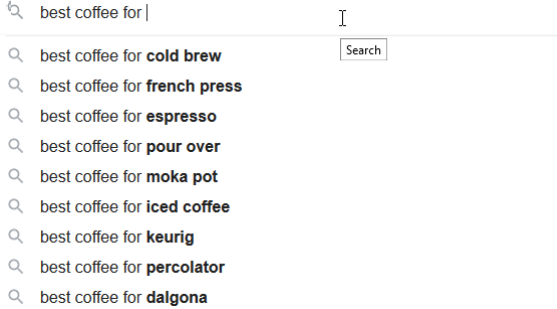
You can see all of the long tail keywords that Google literally gives you to create content around.
The best part?
Your audience gets the same suggestions, which means you’re highly likely to create a blog post around a topic they’re already interested in. Bonus!
Tip #3: Crush Your On-Page SEO to Rank Higher with Google
The next thing you need to do to increase your blog traffic multiple times over is crush your on-page SEO. While this means getting a little technical, it is actually pretty easy to do once you learn how. And there are a few different ways you can make this happen.
Here’s how to do this in four simple steps.
Choose a Captivating Blog Post Title
An attractive headline for your blog post is the selling point of your post. It informs the readers about the article’s content and is the first interaction they have with your blog post.
Think of it as the bait.
So, how do you pick an amazing headline that will captivate readers and make them want to read your content?
Start by making sure the title is accurate, clear, and short.
If you can, make it sixty-five characters or less. Then add keywords to your title to ensure readers know that your content matches exactly what they’re searching for. This will boost your SEO rankings and help increase click through rates.
If you’re having a hard time coming up with captivating titles, here are some helpful tools (headline analyzer) you can use to create captivating titles: Mangools, Sharethrough, coschedule.
Format Your Blog Post Correctly
Before writing your blog post, it is also important to make sure you are formatting your content correctly. Start by preparing an outline that helps ensure your wording and ideas flow smoothly throughout the entire piece.
In addition, it is important to use H tags for your subheadings. H1 to H6 formatting helps break down your ideas into digestible chunks that aren’t super overwhelming to your readers.
H1 is generally reserved for the title of the piece, while H2 through H6 are used for lower levels.
Think of it as a book with a title, subtitle, and chapter headings. But don’t get too caught up in the technical details. It’s usually as easy as changing your formatting in your text editor from “normal text” to whichever type of H tag you want to use.
Here’s how:
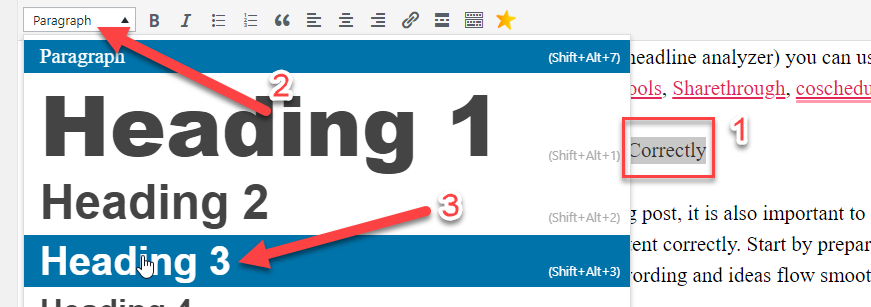
- Highlight your heading in your post.
- Click on the “Paragraph” box section in the formatting section
- Choose the heading you want to use.
Simple as that!
Just make sure you start with a bigger heading and then use smaller ones for subheadings in that section.
What headers should you use?
Here are two worthwhile headers to include in almost every post.
1. People Also Ask
Another tip to improve your on-page SEO is to use the “people also ask” section in Google. All this really entails is looking at this section on Google and creating sub points in your content that relate to these questions.
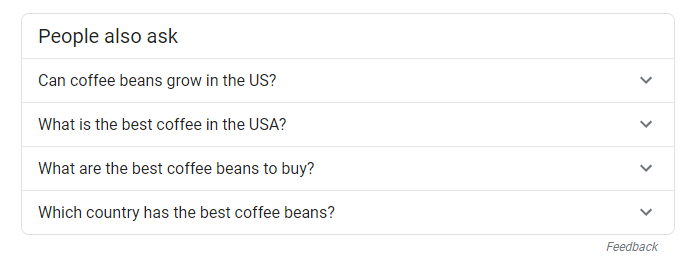
Why does this work?
Well, Google sees it as your content page being valuable for more than one keyword search and content points. And your audience thinks you’ve gained a crystal ball and started reading their minds about other questions they have.
“Searches Related To”
Similarly, you can also use the “searches related to” section at the bottom of a search on Google as part of your post.
For example, if I’m writing an article about coffee beans in America…
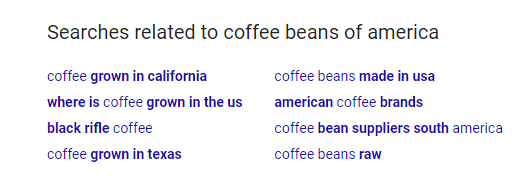
Google tells me people also want to know:
- where is coffee grown in the US
- American coffee brands
- coffee grown in California
- coffee grown in Texas
I would use this information to decide:
- if I include one, some, or all of these as subtopics in this blogpost OR
- are these my next blog posts I need to write and link to because my readers are also interested in these topics.
From a reader’s perspective, this is a great way to access information that dives deeper into a subject they care about. In search engine terms, this shows that your content relates to these other topics in some fashion.
Tip #4: Create Engaging Content
When it comes to blogging, quality is always the most important metric you need to pay attention to.
Crap content won’t get readers to like or trust you. And it most certainly won’t get them to come back again and again to read your new posts.
Thus, your posts need to be informative, engaging, and provide some sort of value for the time that your audience is spending reading them.
Determine the Necessary Word Count to Rank
Before you really get into creating awesome content, you need to determine the necessary word count to rank on major search engines like Google.
If you aren’t sure how to determine this, SEO Minion will tell you for free. However, it is usually a good idea to use at least 1,300 words up to several thousand words depending on the topic.
Here’s an example of using SEO Minion to check your word count.
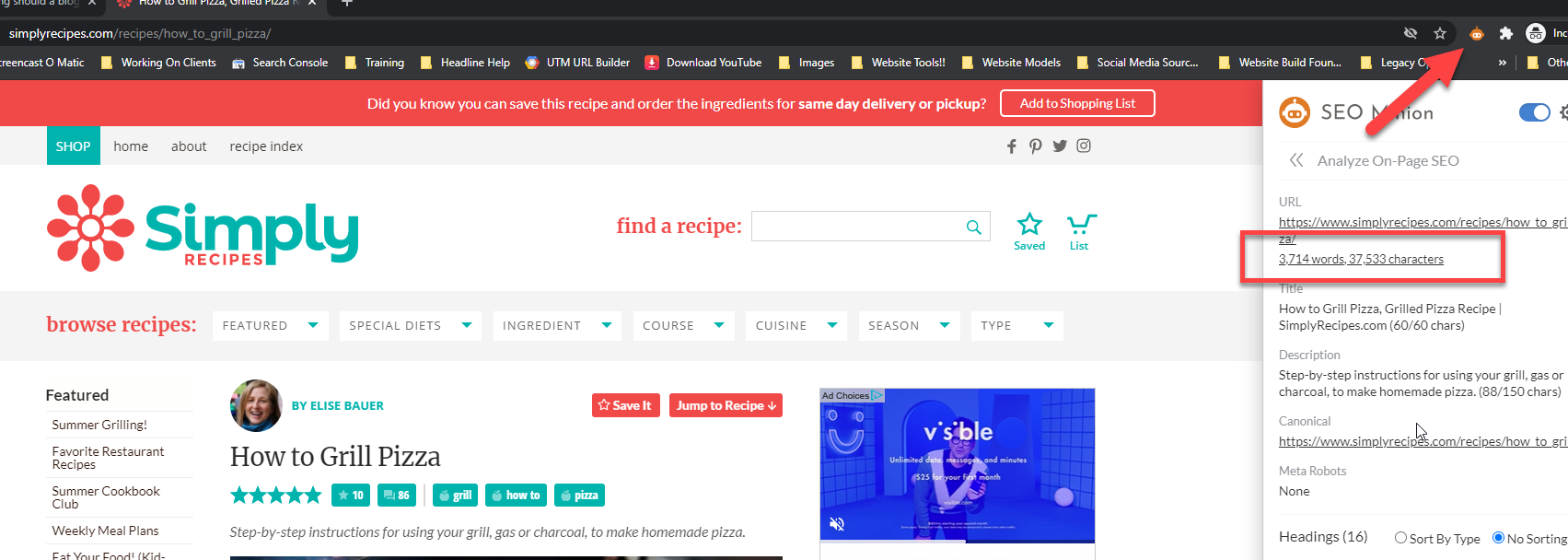
Most readers can tell right away if they want to spend the time reading a blog post based on how it looks. If there are big blocks of text together or it seems a little daunting to the eye, they won’t stay on the page for long.
Thus, it is important to use subheadings and bulleted lists to really get your point across in a visually pleasing manner. And, in most cases, you want your paragraph blocks to be no more than three sentences long.
This will help readers understand your information more clearly and make the post easier to read.
Add Royalty-Free Images
Part of making your content visually appealing is by adding photos. However, if you’re adding images to your blog post, you need to make sure they are royalty-free. Using someone else’s copyrighted photo can lead to a very expensive lawsuit or fine.
Instead, choose high-quality free images from Pixabay, Pexels or Unsplash.
Write a Compelling Introduction
If your title is your bait, then your introduction needs to be the hook.
Create a compelling introduction that clearly explains to your readers what they are going to learn about in your post and why it matters.
This is also a good place to include a few of your top keywords or longtail phrases to help boost SEO.
The important thing to remember here is that it needs to be short. Your introduction should be somewhere between two hundred and three hundred words maximum. You don’t want to bore your readers before they even get started, right?
Tip #5: Conquer Your Blog Calendar
One of the biggest mistakes new bloggers make is by not having a super consistent post calendar. In the end, you want readers to keep coming back on a regular basis to read your content.
If you aren’t publishing on a predictable basis, this can be difficult for them to keep up with.
Furthermore, once you’ve gotten going, Google will crawl your website everyday looking for new updates. If you’re consistently publishing, there’s a good chance you’ll rank for more keywords.
Plan Your Content Out
To make sure you’re always publishing and never running out of ideas, plan your content out at least a month in advance. Know exactly which days you are going to post and what you want the topic to be about.
You can even write or outline these posts ahead of time, giving you the opportunity to schedule them in advance for going live on your website. The key takeaway is to choose a calendar you can stick with. Is it one post a week? Five? More?
Create a Consistent Writing Time
Just when you think you’re done writing posts for your blog, keep writing!
Think of your website as a piece of real estate:
Each post you write is another room you add on to your little castle on the internet. The more rooms you have, the bigger the home and the more your property is worth.
As you add more content to your blog, there are more opportunities for someone to find and fall in love with your content.
So, just when you think you’re done writing about a particular topic, add another post to the mix.
Tip #6: Exploit the Best Social Media Channels

In order to gain more traffic to your blog, you also want to use the best platforms for social media. Here are a few ways to get this done.
Choose the Right Platform for Your Audience
What this really means is choosing the right platform for your audience.
For example, if your blog is about cooking, parenting, or beauty tips, you’ll probably be pretty popular on Pinterest. But if your main topic is about car engines, it’s probably a good idea to use something like YouTube to promote your content.
If you’re planning on posting on various social media platforms, make sure you’re creating post images based on each platform’s various size and ratio guidelines. Create at least one image per platform for every new blog post you publish.
This helps tell your audience on your favorite social media channels exactly what you’re talking about in the post and gives them a solid reason to click on your link.
To easily get the right size images, use a tool like Snappa.
Get Creative in Cross Posting
One area where a lot of new bloggers miss out is cross posting the same content across multiple platforms using various mediums.
As an example, you could take a few headlines from your latest blog post and turn them into quick one to two minute YouTube videos.
You could also use the information in your post to answer questions on Quora.
How does this work?
Find a specific question related to your niche and write an extremely helpful answer. Then add a link to your blog to go even deeper, which will bring tons of traffic to your site.
Ignore Facebook for at Least a Year
Skipping one of the biggest social media platforms out there might seem counterintuitive. But the truth is that Facebook is super pay-to-play right now and organic reach is crushed, which can mean shelling out tons of cash to really only get a small amount of traffic.
Instead, leave this time suck distraction alone. Pass on it and keep publishing new blog content instead of Facebook posts that die in five hours.
Tip #7: Make Connections to Increase Your Audience

Last but not least, our final tip for growing your blog traffic exponentially is to make the right connections.
What do we mean by this?
Well, get in touch with social media influencers, other bloggers, and those with decent mailing lists. Build a relationship with them so that they are very willing to share your latest blog posts with their already curated audiences.
Here are a few examples.
Other Bloggers
Finding other bloggers who post about content related to yours is a great way to grow your traffic.
Why?
Well, for starters, their audience is probably already interested in the topic you’re presenting or they wouldn’t be on this other person’s blog.
In addition, the other blogger likely has more experience in bringing in traffic than you do or has various marketing channels in place. While leveraging what they have to offer by pairing it with your efforts, you can really see an increase in your audience.
Podcasters
Podcasts are more popular than ever before. Those who produce and publish them know their audiences very well and have a good idea whether the topic you’re blogging about fits in with their content.
Reach out to podcasters who publish in your niche and ask if there’s any sort of joint venture they would like to do. Most are very willing to partake in this kind of exchange and will likely even offer to interview you for an episode of their series.
YouTubers
Much like podcasters, YouTubers understand the value of creating engaging and informative content. If it makes sense for your niche, it is always a good idea to reach out to those producing video content that matches the type of written content you publish.
This can be done through an interview, discussion, or even a short presentation. Sometimes, YouTubers even just publish their reaction to reading your content. These are all great ways of leveraging their audience to become regular readers of your blog.
Influencers with Email Lists
Another group you really want to reach out to is influencers with email lists. These people generally have very responsive and captive audiences that hang on their every recommendation and word. By working with them on a joint venture, you can capitalize on a gain in traffic just by having your blog link included in their email blast.
So, how do you find them? Sign up for lists in your niche. Email the blog owners and ask to do a joint venture. You’ll be surprised at how many are responsive to this.
Wrap Up – Tips for Growing Your Blog Traffic 10X
Let’s review how to get people to read your blog:
- What types of posts should you write?
- Choosing the best keywords
- Crush your on-page SEO
- Create engaging content
- Conquer your blog calendar
- How to exploit the best social media channels
- Make the right connections
Now that we’ve covered these seven tips for growing your blog traffic tenfold, you’re ready to get started.
Remember, they only work if you actually put them into practice. So, go out there and implement them immediately!

